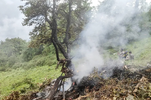Incident comes days after an Air India plane crashed in the western Ahmedabad city, killing all but one of 242 on board.

www.aljazeera.com
Seven killed in helicopter crash in India’s Uttarakhand state
The incident comes days after an Air India plane crashed in the western Ahmedabad city, killing all but one of the 242 on board.
Smoke billows from the site of the helicopter crash near Gaurikund, Uttarakhand, India, June 15, 2025 [Uttarakhand's State Disaster Response Force via AFP]
Published On 15 Jun 202515 Jun 2025
Seven people, including a toddler, have been killed in India’s northern Uttarakhand state when a helicopter ferrying them for a Hindu pilgrimage crashed in the Himalayas, officials say.
Officials from the Uttarakhand Civil Aviation Development Authority told reporters the chopper took off at about 5:30am (00:00 GMT) on Sunday from the temple town of Kedarnath for Guptkashi, a town some 37km (23 miles) away, but crashed shortly after takeoff.
The deceased have been identified as the pilot, Captain Rajveer Singh Chauhan, and passengers Vikram Rawat, Vinod Devi, Trishti Singh, Rajkumar Jaiswal, his wife Shraddha Jaiswal and their two-year-old daughter, Kashi.
The bodies were badly burned in a fire that followed the crash, authorities said.
Uttarakhand’s State Disaster Response Force told the ANI news agency that the crash site is located in a remote and dense forest area, adding that the rescue operation is under way in coordination with the local police.
Officials said the crash was believed to have been caused by poor weather conditions.
In a post on X, Uttarakhand’s Chief Minister Pushkar Singh Dhami called the incident “very sad”.
Kedarnath, standing at an altitude of 3,584 metres (11,759 feet), is home to one of the four most sacred Hindu temple shrines and receives tens of thousands of pilgrims each year during the summer season.
To avoid the arduous trekking in the mountainous terrain, affluent pilgrims often use helicopter charter services. But mishaps are common in the treacherous region, where sudden weather changes and high-altitude flying conditions can pose risks.
On June 7, a helicopter operating in the Kedarnath Valley made an emergency landing on a highway due to a technical fault shortly after taking off. The pilot was injured, but all five passengers on board were unharmed.
Last month, a helicopter crashed in Uttarakhand’s Uttarkashi district, killing six people, including the pilot. One person survived.
Indian media reports said Sunday’s crash was the fifth such incident in less than two months. It also came only days after an
Air India plane crashed in Ahmedabad city, killing all but one of 242 passengers on board and dozens of others on the ground.









